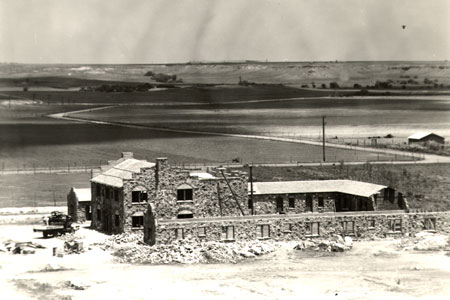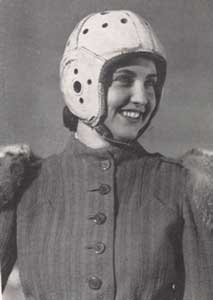by Dr. Peter Petersen, professor emeritus of history
The J.A. Hill Era, 1918-1948
 In September 1918, R. B. Cousins resigned as president, and the Board of Regents promptly selected as his replacement history professor J.A. Hill, who would hold the office for the next 30 years.
In September 1918, R. B. Cousins resigned as president, and the Board of Regents promptly selected as his replacement history professor J.A. Hill, who would hold the office for the next 30 years.
Hill immediately joined in a statewide debate about whether a four-year curriculum at a Normal College would be an "unnecessary duplication" of programs offered at other institutions of higher education, particularly the University of Texas. The issue was apparently resolved in 1922 when the Texas State Department of Education approved the granting of a bachelor's degree by West Texas State, making it the first Texas Normal College so authorized. Work began immediately on curricular revision. Meanwhile, the legislature changed the institution's name to West Texas State Teachers College, thus acknowledging its new status. In 1922, WT, along with four of its sister colleges, was admitted to the American Association of Teachers Colleges in Class A rank. Three years later (1925), the Association of Colleges and Secondary Schools of the Southern States granted admission. A year earlier, the college accepted an invitation to join the National Collegiate Athletic Association.
 As the college completed its first decade, it became obvious that additional facilities were needed. In 1920, a dormitory for women was opened. Named after the former college president, Cousins Hall was the first dormitory built by the state on the campus of a teachers college. President Hill continued to lobby the legislature for additional funds, but it was not until 1927 that the college secured an appropriation for construction of a second academic building. Opened in 1928, the $300,000 Education Building, located just west of Old Main and now "mothballed," housed the training school.
As the college completed its first decade, it became obvious that additional facilities were needed. In 1920, a dormitory for women was opened. Named after the former college president, Cousins Hall was the first dormitory built by the state on the campus of a teachers college. President Hill continued to lobby the legislature for additional funds, but it was not until 1927 that the college secured an appropriation for construction of a second academic building. Opened in 1928, the $300,000 Education Building, located just west of Old Main and now "mothballed," housed the training school.
State and national recognition and improved facilities gave the school an outward appearance of permanence, but by the late 1920s, WTSTC leaders faced new problems that collectively threatened institutional survival. After nearly 15 years of having the Panhandle and much of the surrounding area to itself, WTSTC suddenly found itself in competition with several new institutions disturbingly close to Canyon. In 1925 Texas Technological College, with a Department of Education, opened in Lubbock, some 110 miles to the south. About the same distance to the north, just across the Texas border, Oklahoma Panhandle A&M College became a senior institution in the 1920s, while 110 miles to the west, New Mexico established in 1927 a state junior college featuring education for teachers in Portales, the center of the "Little Texas" portion of that state. Finally, in 1929 Amarillo Junior College began operation just 15 miles from the WTSTC campus.
Adding to the uncertainty was the onset of the twin disasters of depression and drought. When a Joint Legislative Committee on Organization and Economy issued its report in 1932, a proposal that the state's teacher colleges be reduced to junior college status and made branches of the University of Texas topped the retrenchment list. The introduction of several bills to this effect in the legislature during its 1933 regular session set off a spirited debate about the future of teacher education in Texas. Eventually, the bills were defeated, but WTSTC did not emerge from the battle unscathed.
The legislature slashed the school's appropriation in half and subsequently the Board of Regents asked that it discontinue its graduate program in 1931. (The school conferred 25 master's degrees during the period 1931-1933.) The continuing financial crisis resulted in a substantial reduction of faculty.
 Frustrated by the parsimony of the Texas Legislature, WTSTC leaders turned to the federal government for help. By conservative estimates, approximately 25 percent of the student body worked for such New Deal agencies as the National Youth Administration (headed in Texas by Lyndon B. Johnson), the Civil Works Administration and the Works Progress Administration. Many of these projects took place on campus and resulted in substantial improvement in the physical plant. One visible legacy from this time is the Buffalo Courts Building, which currently houses the Alumni Association offices.
Frustrated by the parsimony of the Texas Legislature, WTSTC leaders turned to the federal government for help. By conservative estimates, approximately 25 percent of the student body worked for such New Deal agencies as the National Youth Administration (headed in Texas by Lyndon B. Johnson), the Civil Works Administration and the Works Progress Administration. Many of these projects took place on campus and resulted in substantial improvement in the physical plant. One visible legacy from this time is the Buffalo Courts Building, which currently houses the Alumni Association offices.
Despite its financial woes, WTSTC continued to expand and change its curriculum. In 1935 the Board of Regents authorized the resumption of graduate study and, after expansion of the business program, the conferring of the bachelor of business administration degree. In November 1937 the Board of Regents approved the removal of courses in education from the requirement for a bachelor's degree, and pre-medicine, pre-law and other pre-professional courses were begun. Not until 1941 did the legislature approve $170,000 in funding for additional facilities, this time a science building.
World War II cut sharply into student numbers. Enrollment in the fall of 1942 fell to nearly 700, and in the long-session of 1943-1944 a low of 505 was recorded. Only 373 students attended summer school in 1945, the smallest number since 1915. The war also resulted in a substantial turnover among the faculty. If the end of the war produced a rebound in student numbers, as many expected, then rebuilding the faculty would be a major priority.
West Texas A&M Presidential Eras
- 1910-1918: The R.B. Cousins Era
- 1918-1948: The J.A. Hill Era
- 1948-1973: The James P. Cornette Era
- 1973-1989: The University Under Watkins, Sherman, Shannon and Roach
- 1989-2005: System Membership and the University Under Thompson and Long
- 2006-2016: The University Under O'Brien
- 2016-Present: The University Under Wendler
